#nick deocampo
Text
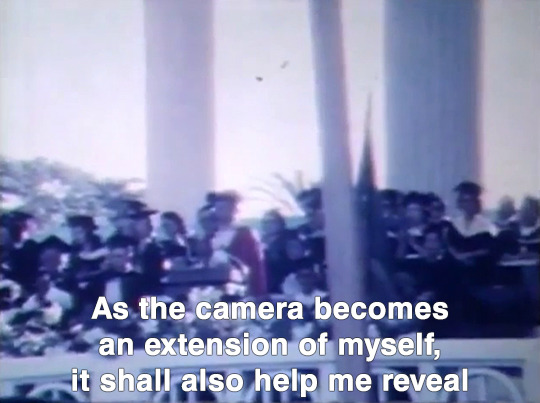

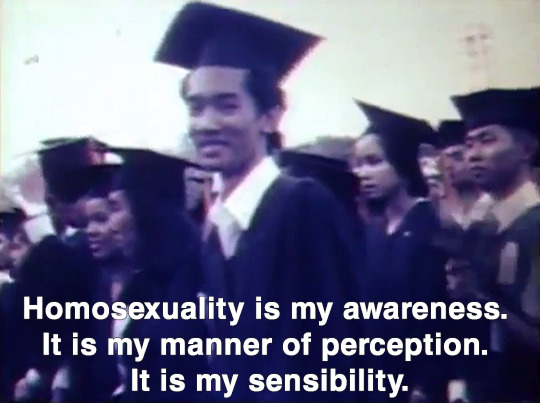
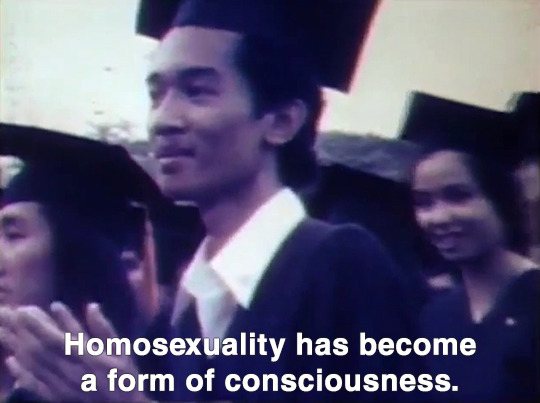
Revolutions Happen Like Refrains in a Song (1987)
direksyon ni Nick Deocampo
#revolutions happen like refrains in a song#nick deocampo#documentary#philippine cinema#pelikulang pilipino#dokumentaryo#screencaps#world cinema
56 notes
·
View notes
Text



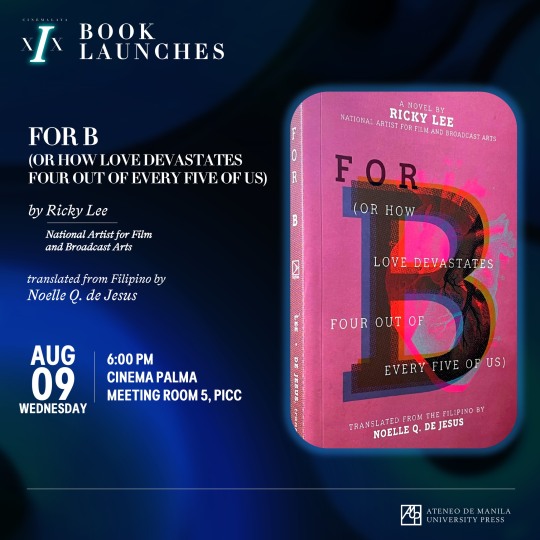

From Cinemalaya Facebook Page: ANOTHER REASON FOR YOU to be at the PICC this CINEMALAYA XIX: CINEMALAYA BOOK LAUNCHES. Apat na libro ang aming ilulunsad ngayong taon.
SINETALA by Nick Deocampo
LAHAT NG B (Karugtong ng Para Kay B) by National Artist for Film and Broadcast Arts Ricky Lee
FOR B (Or How Love Devastates Four Out of Every Five of Us) Translated from Filipino by Noelle Q. de Jesus
CCP ARTHOUSE CINEMA: Programming the Pandemic by Adjani Arumpac
7 notes
·
View notes
Text

Sir Nick Deocampo #Idol
Filipino filmmaker and film historian
Documentaries
Children of the Regime (1985)
Revolutions Happen Like Refrains in a Song (1987) @nbdbphilippines @bookfestph
1 note
·
View note
Text
naalala ko na tinugtog ito ng Kjwan sa Silent Film Festival. nilapatan nila ng tugtog ang sineng Zamboangga.
mga interesanteng anik-anik sa sine
-bida dito si Fernando Poe, yung tatay
-1936 ang sine pero may underwater scene
-ipinagpalagay "lost film" na ito pero may nakitang kopya si Nick Deocampo sa US Library of Congress. bago pa ito napasailalim sa pangangalaga ng Library of Congress, nakuha ang kopya ng sine sa Finland.
1 note
·
View note
Photo







Oliver (1983)
ni Nick Deocampo
The first instalment in Nick Deocampo’s Ang Lungsod ng Tao ay Nasa Puso trilogy, Oliver follows a female impersonator who supports his family by performing in Manila’s gay bars during the Marcos dictatorship. It is one of the most compelling illustrations of the fluidity of sexuality, as well as of the power of human agency in times of hardship.
#kalakian#filipino documentary#filipino docu#dokyu#daangdokyu#daang dokyu#pilipino#filipino#oliver 1983#lgbtqia+#lgbtq docu#pilipinas#philippines
22 notes
·
View notes
Photo




I am privileged to be one of the representatives of the university at the MTRCB's 6th Family and Child Summit in Cebu City and witness the plenary talks of Professor Nick Deocampo, Film Historian and U.P. Professor; Director Jose Javier Reyes, Multi-awarded Film Director and DLSU Literature Professor; Veteran actress Ms. Gloria Sevilla, etc.
24 notes
·
View notes
Text
#atthemoment 10am Watching UP Film Prof. Nick DeOcampo on Teleradyo on Semiotics and new film courses in U.P.
#atthemoment 10am Watching UP Film Prof. Nick DeOcampo on Teleradyo on Semiotics and new film courses in U.P.

View On WordPress
0 notes
Text
MATERIALISM IS A EUPHEMISM: Excerpts from the first Kalampag Tracking Agency screening, UPFI Videotheque, 2014

The Kalampag Tracking Agency was initially started as “a screening program in the form of an initiative.” An organizational collaboration between Shireen Seno of Los Otros and Merv Espina of Green Papaya under its Generation Loss (GEN_LOSS) program, Kalampag sought to present some of the most singular, fragile, and striking moving image works by Filipinos over the past 30 years. The initiative was launched by two screenings and discussions, the first of which took place on 20 August 2014 at the University of the Philippines Film Institute (UPFI) Videotheque.
The impulse of Kalampag led to ongoing research and archiving of Philippine artists' moving image that branched off into other projects, such as the ongoing Light Leaks series currently hosted by the Museum of Contemporary Art and Design (MCAD).
Advancements and ongoing experimentation with digital technologies and artists’ moving image creation and distribution are ever accelerating at breakneck speeds, perhaps even more so now because of the conditions set about by the pandemic. Who could have imagined that in less than a decade since the first Kalampag screening that watching videos from our smartphones would become normal behaviour? Most of the artists, collaborators, and curators had no smartphones during the preparation work for the Kalampag in 2014.
Below is an excerpt from a lengthy post-screening discussion between Alice Sarmiento, Raya Martin, John Torres, Nick Deocampo, and Merv Espina. Shireen Seno, Kidlat Tahimik, Kidlat de Guia, Teddy Co, Jon Lazam, Martha Atienza, Malay Javier, and many others were in attendance and actively contributed to the discussion. What follows is an example of the performative and participatory nature of the screening program and the post-screening discussion that further enriches the materials and informs ongoing research.
*****

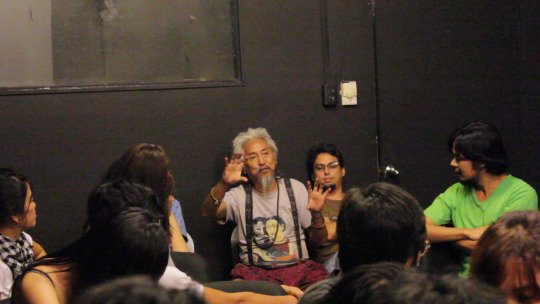
Alice Sarmiento (AS): To append to what Nick [Deocampo] and Raya [Martin] were talking about earlier, I think one of the interesting things I noticed from the second half was this element of decay that was present in almost all the films. I know it has to do with bad prints or whatever, but the fact that it’s present in these films from the past, if you look at the current visual vocabulary especially with something like Instagram, you’ll notice that decay is something we simulate now using technology.
The thing with technology now is that we’re coming from a place of abundance where it’s super easy to flatten everything, but everything is also infinitely reproducible so we’re talking of a very different garbage pit altogether. We’re not talking about the dumpster behind LVN Pictures or Mowelfund, we’re talking about how to work and sift through a different pile of garbage. We now have concepts like infinite reproducibility, flattening, and simulating decay and the fact that there is no limit to what you can upload to YouTube. These really change the potential for what film is going to be in the future or what we’re experimenting with.
I have a really horrible example right now. I saw the trailer for Sex Tape (2014) earlier, starring Jason Segel and Cameron Diaz. One of the things there is that they have an iPad and they filmed themselves having sex for three hours which accidentally got uploaded to the cloud. So, we’re talking about a generation that’s born into this concept of the cloud.
To add to what Teddy Co was saying about communities earlier, we’re not even talking about forming communities. We’re talking about a population that’s literally native to this idea of filming themselves and publicizing everything they do. I think those are the things that are completely beyond our grasp right now. The fact that the common, the public sphere, and the act of disseminating something have all changed.
Of course, you have technology as the culprit for all of that but I think that, rather than feel nostalgic or like you’re being displaced, just understand that technology never really displaced or displaces us, but more like it adds to what is present. Thank you, Raya, for laughing.


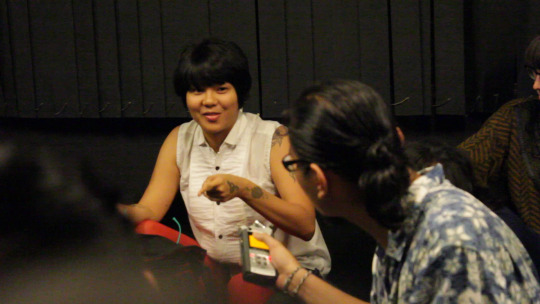
Raya Martin (RM): No, I think I kind of understand it…
Merv Espina (ME): Well, I agree.
RM: Sorry, just a footnote, but what you said about that certain aesthetic of bringing together the older and newer works, of course we still don’t see it yet, but what if this sort of cinema from the ‘70s is now in this one big app or website?
AS: Well, yeah. Because if we think about it, the people who are using Instagram now are the people who have access to smartphones. Who are these people who have access to smartphones? It’s people who were born in the ‘70s and ‘80s. So, there will still be that hampering that, “When I was a kid, it was like this.” We’re still the generation that can recognize that kind of frame. I’m sure that if I show it to my nieces, they’re not gonna have any idea what celluloid and those frames are. They’re gonna think, “Oh, that’s the thing they have on Instagram right?” It has now become a filter. It’s another way of co-opting that language from the past, but that is something that came up. It’s something that they’re going to translate in their own hands.
RM: In the same way, I’d like to say that experimental cinema turned into a music video aesthetic.
AS: Yeah, that’s what I recognized also. I’m sure that Nick sees something else when he sees the videos of Roxlee, but I was like, “It’s like that Peter Gabriel video.”
Nick Deocampo (ND): This is the reason why I’m more of a historian than a filmmaker right now because the fear that I have in what we’re discussing is that you tend to efface the historical markings that are necessary to inform us of the state of technology, politics, economics, society, our mental well-being.
I’m sorry if I or some of us here may sound nostalgic because, in the end, I think it’s a kind of temporal framing. That’s also our legacy. One thing you may understand is that materialism is a euphemism of Marxism. You belong to that generation where the material reality, all of these were part of the process that we were in. That’s what I’m trying to caution ourselves; that unless you see that, it’s just a style that belongs to a certain temporal continuum, which technology enriches and adds up.
We still need to demarcate exactly that this technology in the ‘70s is different from the ‘80s. I’m sorry to be so chronological about it. Of course that kind of historical periodization can be put into a question or argument, but I feel that there’s still room for a historical nuancing for us to know what is still useful. Again, being informed is all I’m asking for and that’s why, as I’ve said, I engage in history because this country, our people primarily, tend to forget so easily.
AS: I think the fact that it’s becoming added to the argument is a result of a very interesting point that we started to realize what technology has to do with the formation of communities and how it influences aesthetic because you’re working from a place with limitations.
ME: There are still a lot of limitations with digital, so much.
ND: Codec issues.
AS: Yes, there is! I only mean to bring up how that is going to be augmented in the future especially now that you see 15-year-old filmmakers and 8-year-old app developers. I mean, those are very interesting developers right now. One of the things that concerns me at least, is how optimized it’s becoming with how people develop things. It’s becoming more convenient and more possible to just confine yourself to your room and do your own thing there without having to relate to people in this space because dissemination and screening mean something else now.
ME: We’ve all been very nostalgic about form, material, and how your works from the ‘70s and ‘80s were disseminated. Now that you’re focusing on the digital, no one has questioned or brought to attention the politics and possibilities of distribution when it comes to digital forms. There are so many ways to distribute. Cross-referencing with what you were saying about community, of course communities are developed from screenings and workshops because you literally had to be physically present in the workshops and the screenings.
ND: Now it’s all virtual.
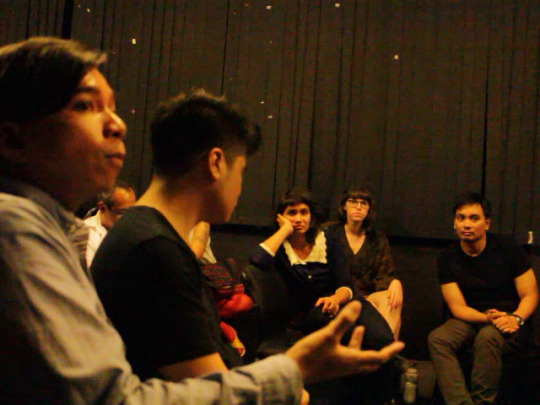


ME: Yeah, and now, for example, some of the Marcos-era films can actually be seen online. Jon, what works do you have online? [Hindi sa Atin ang] Buwan (The Moon is Not Ours) (2011)?
Jon Lazam (JL): Yes, Buwan.
ME: You can see some of Raya’s works if you download.
RM: But I’m more old school, you have to pay for it.
John Torres (JT): I like watching in a big dark room with the others. Some people prefer to download and watch in solitude at home. Inside the cinema, I don’t have the remote so I power through a contract of continuous playback. If it were just me and the remote, I could take my sweet time and take breaks or naps. Or I could just decide not to watch altogether. I like both.
Teddy Co (TC): It’s also a discipline not to answer any phone calls!
ND: As a challenge to the curators here: why don’t you try to program something digitally? Because this actually questions the very practice of why you have to have a physical screening like this and bringing us together. Of course, we are rushing here because this is a sacred ritual as far as we’re concerned. Now, here’s the challenge: we won’t see each other. Let’s see what results you’re gonna have and inform us, maybe we’ll see each other. Again, it’s not a question of comparison of which one is better. We want to see exactly how we can move on from this old ritual of getting together, talking to each other, and trying to exchange or share some ideas. I know that on the internet, we somehow can, we can comment immediately. So, let’s move on to that.
If I sound so nostalgic, then I just want to correct one thing. It’s just an impression that maybe we sound nostalgic but personally, I’d like to say that we’re not. In fact we do recognize the materiality of video technology and that cinema has moved on. As I said before, my works right now involve digital technology and my documentaries have CGI. I’ve reconciled myself with the technology. It’s just that once again, we’re burdened by history. And don’t worry, 20 years from now, Raya, all of you will be speaking the same language when we are in the age of holograms. You know, I’m sure digital media will be over! Holograms will be here and that’s where the new masterpieces will be. We don’t even have to see each other, we’ll just be projected there.
*****
#ThrowbackThursday #greenpapayaarchives #KalampagTrackingAgency #experimentalfilm #videoart #artistsmovingimage #losotros #losotrosfilms #lightleaks
This excerpt has been edited for length and clarity. Some parts were translated from FIlipino.
*****
Images by Neo Maestro.
If you can:
https://greenpapaya.art/donation
0 notes
Text
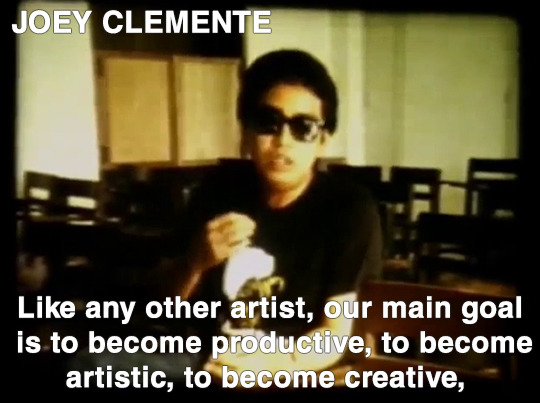
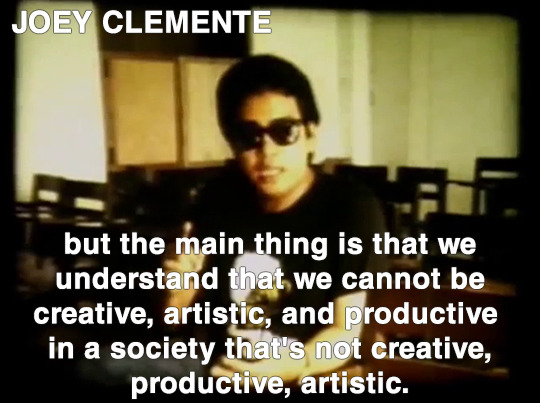
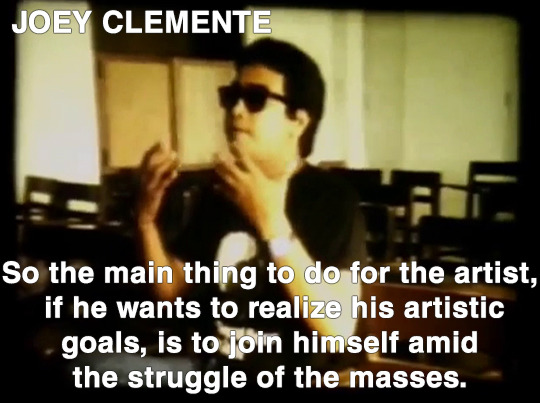
Filmmaker Joey Clemente on why filmmakers get involved in political issues
Revolutions Happen Like Refrains in a Song (1987), direksyon ni Nick Deocampo
#revolutions happen like refrains in a song#nick deocampo#filmmaking#philippine cinema#pelikulang pilipino#documentary
10 notes
·
View notes
Text
PELIKULANG PILIPINO, PILIPIT ‘NO?
“Its reconstruction of the past looks back at a major historical juncture that saw significant events happen – the decline of the Spanish rule, the birth of the Filipino nation, and the advance of the American imperialism. In this whirlpool of change, cinema was introduced and its growth paralleled historical events surrounding and shaping the formation of the Philippine republic in the coming century. Born as twin to the nation, cinema mirrored historical conditions shaping the destiny of the emerging nation.” (Film: American Influences on Philippine Cinema by Nick Deocampo)
Ang mga pagpapahalaga kung saan umiikot ang mga pelikula ngayon ay nagmula pa noong unang panahon na sumasalamin sa estado ng ating bansa at sa epekto ng mga sumakop dito. Dahil sa mga kastila at amerikano ay natutunan natin na maganda ang mga mapuputi at dapat nating kamuhian ang totoong kulay natin na kayumanggi, Tinangkilik natin ang mga produkto na pampaputi upang maging katulad tayo ng mga sikat na artista sa amerika. Tinakpan natin ang ating sariling pagkakakilanlan dahil ito ang ipinasok ng mga palabas sa ating isip. Dulot din ng mga pelikula at pati na rin ng maling mensahe ng relihiyon ang pag-iisip natin na ayos lang manatili sa kahirapan dahil pinagpapala naman ang mga ito. Hindi ko naman sinasabing mali ang relihiyon bagkus ay mali ang paniniwala ng ibang tao na dapat makuntento na sila sa buhay mahirap dahil ito ay nagpapakita lamang ng ating pagiging balintiyak at nagbubukas ng pinto para sa mga kapitalista at naghaharing uri na mas lalong palakasin ang kapit nila sa mga nasa ibaba. Ang pinakakinabahala ko ay ang pag-iisip na maganda pa ang daigdig dahil ito ay nagpapatunay na tayo nga ay bulag na mula sa pagiging tutok sa mga ihinahain sa atin ng may kapangyarihan.
Sabi nga ni Christine Gamao, “Magsisilbi ang mga malayang pelikula bilang mabisang pamamaraan upang maipataas ang panlipunang kamulatan ng awat manonood nito. Patuloy na naiiralin ang iang kulturang makabayan, siyentipiko, at makamasang uri ng sining, particular na sa industriya ng pelikula, kaiba sa nakagisnang pyudal, burgis at kolonyal na kultura sa paraan ng sining na higit na mapagpalaya. ”
Ang layunin dapat ng mga pelikula at iba pang manggagawang Pilipino ay ang maging instrument ang kanilang akda upang maging mulat ang mga tao sa isyu ng bansa. Hanap ng mga tao ang aliw at ang mga bagay na magpapasaya sa kanila kaya dapat na gamitin ito ng mabuti upang hindi magpatuloy ang baluktot na pag-iisip ng mga Pilipino. Para naman sa mga kapwa ko na manonood at naghahanap ng aliw sa mga palabas at dapat na maging maging mas alerto sa mga pagpapahalaga na itinuturo ng mga palabas. Dapat ay matutunan natin na mag-isip at maging mapagtanong sa mga nangyayari sa lipunan. Mahihinuha natin na hindi lang dapat aliw ang hanap natin sa mga pelikula bagkus ay dapat nating hanapin at intindihin ang tunay na mensahe nito at huwag tangkilikin ang mga pelikula na may mga baluktot na pagpapahalaga. Dapat ay magkaroon tayo ng malawak na pag-iisip kung saan hindi lang puro kuha at tanggap bagkus ay nag-iisip at naghahanap ng katotohanan.
0 notes
Photo

A Long "Lost" 106 Year-Old Film Shown at 13th #InternationalSilentFilmfest - Manila 2019. Noted Filipino film historian Prof. Nick Deocampo gave a brief lecture to introduce the film "Native Life in the Philippines" to open this festival at SM Aura last night, 30 August 2019. No record shows that this film was theatrically screened in the country after more than a century after it was made in 1913. The film is the 1st ever full-length documentary produced in the Philippines. It courted a storm of controversy during its release in the USA in 1914. Directed and produced by the controversial American colonial administrator in the Philippines and renowned anthropologist Dean C. Worcester, the film is about the natives living in the Cordillera mountains whose appearance and lifeways were described in major American newspapers such as The New York Times in demeaning ways: "savage, naked, dirty, primitive, bestial, uncivilized, headhunters, dog-eaters, cannibals, non-Christian," and “Little Brown Brothers”. The film was used as propaganda in Worcester’s campaign to delay the granting of early Philippine independence as he discredited Filipinos (shown as half-naked natives) for “not being ready” to be independent and needed America’s continuing tutelage. Nueva Fuerza (Bag-ong Kusog) was strong in denouncing Worcester for making the film—“an American who (was) the worst enemy of Filipinos”. The film was considered “lost” for a long period of time until a copy was discovered at the basement of the University of Pennsylvania and later restored. During its centennial in 2014, Prof. Deocampo was part of a panel during a conference held at the University of Michigan (Worcester’s alma mater), where he made a presentation of his researches on the film, long before a print was even discovered. He presented last night major highlights regarding "Native Life in the Philippines" in relation to the country’s film history, once more proving the pioneering importance of non-fiction films in documenting Filipino life. The screening was accompanied by music from #Munimuni, an indie band known for their signature "makata" (poetic) pop.😍 #ISFFManila2019 #Travel #Backpacking (at SM Aura Premier) https://www.instagram.com/p/B1z1wHxhavK/?igshid=1olhcmy7znsgg
0 notes
Text
J. Neil Garcia: Textualizing Realistic Portrayals
by Cristina Eloisa A. Baclig

photo by KOBE ADAM JOSHUA S. LAURENA
BITTERSWEET. This is how J. Neil Garcia describes the life of homosexuals in the Philippines.
As a creative writer, to write well is always the primary concern for his works. But as an author of LGBT literature, works about homosexuality are important in challenging the stigma of being non-normative on gender and sexuality. The Journalism alumnus asserts that challenging and eventually destroying the stigma is possible by confronting homophobia and prejudice head-on.
Inspiration drawn from self-estrangement
Before he knew of his homosexual identity and wrote pieces on homosexuality, he always wrote about his feelings. “I remember being different, not necessarily in a sexual sense, back when I was very young. I believe I’ve always written out of this ‘estrangement,’ this sense and/or sentiment of being different,” Garcia says.
At an early age, Garcia‘s profound grief of being separated from his best friend Hazel inspired him to write his first poem.
To continue writing truthfully, he made himself aware that he is different from other individuals. He started to embrace his uniqueness and, along with gender and sexuality, incorporate it as a theme for his works.
Oscar Wilde, Andre Gide, Edmund White, and Allen Ginsberg initially inspired the multi-awarded writer to start writing about homosexuality. However, it was in his sophomore year at the University of Santo Tomas (UST) when he solidified his interest.
After an invitation from his Humanities professor, he attended the lecture of local filmmaker Nick Deocampo, who showcased an exhibit of homoerotic images and poems at the Goethe-Institut. Garcia saw the acclaimed Deocampo read his “gay and sexually frank” poems on stage—a moment that moved him to write about homosexuality.
“Literature is one of the most effective ways of creating empathy because it allows us to become all kinds of people. [W]hen we read a story or a poem, we are incarnated, as it were, reborn into the perspectives of characters we are not and literally cannot be,” he explains.
LGBT literature, for Garcia, is the most efficient way to represent the LGBT community and explain its difference, which the prevailing bigotry, hatred, and ignorance overshadow, to the larger world.
The continuous struggle of LGBTs caused by the intolerance of society against them and the backlashes against their human rights are just few of the issues that Garcia is facing not only as a homosexual but also as a writer. However, with the inspiration and unconditional love that he receives from the people he knows, Garcia was able to find courage in writing about homosexuality, which inspired many young Filipino LGBTs to discover and embrace their identities.
A new representation
Aside from his poetry collections, one of which includes his most compelling poem titled The Conversion, and his literary and cultural criticism works, Garcia edited the widely known Ladlad, anthologies of Filipino gay writing.
His works made an impact in the Filipino culture by opening the doors for LGBT books, films, plays and other forms of media.
Just like what he wrote in the second Ladlad, perhaps his works portraying the homosexual life exists to remind his readers that there is nothing wrong with homosexuals and just like everybody else, they are also capable of love. Moreover, Garcia wrote how the first edition published in 1994 made the teaching of gay literature classes possible in at least two major universities, and how it became a required reading for Philippine literature courses in the United States.
“Homosexuality is still not mainstreamed or ‘normalized’ enough in the popular spaces of our culture,” Garcia says. He explains that very few images of the bakla in television and films have respectful representations which portray humanized LGBT characters.
For Garcia, his own interactions with and experiences and inspirations from different members of the LGBT community enabled him to portray the diverse and complex face of Filipino LGBT in his works.
Ample room for improvement
Garcia describes his experience in writing LGBT works as “wonderful and exhilarating” and acknowledges his literary pieces as life-altering for Filipino LGBTs. Still, he insists on having more work to be done.
As a professor of English, Creative Writing, and Comparative Literature at the University of the Philippines (UP) Diliman and an associate for poetry in the UP Institute of Creative Writing, he suggests to incorporate a “gender-sensitive perspective” in teaching literature and integrate LGBT works into the primary readings of literature courses in higher education.
“[W]e need to complement this ‘Canon-building’ project with the promotion of feminist and anti-homophobic critical and pedagogical approaches. This way, whatever text our students may end up encountering both inside and outside the classroom, they will be properly equipped to critique them.”
For young writers who are interested in writing about homosexuality, Garcia advises: “Go ahead, follow your creative and literary bliss. Remember, the question of being an LGBT artist or writer isn’t about preferring certain subjects or themes over others. Ultimately, it’s about the adoption of a simultaneously artistic and critical subject-position that willfully calls out, interrogates, and challenges gender and sexual inequality wherever it may be found.” F
Link: http://abtheflame.net/j-neil-garcia-textualizing-realistic-portrayals/
0 notes
Text
youtube
nakakalungkot na wala tayong na- archive na mga hand painted movie posters. commercial art nga sabi ni Nick Deocampo kaya siguro hindi pinapansin ng mga art critic. konting recognition man lang sana para sa mga pintor na walang mga formal art training/education. sino ba naman ang mag-aakalang mamamatay ang stand alone cinema.
naalala ko ang Okey Ka Fairy Ko at ang Batman Returns. napanood ko sila sa mga stand alone cinema sa Taytay noon. may baon kaming pandesal na may palaman na hotdog. dadaan muna kami sa isang sari-sari store para bumili ng isang litrong coke at isasalin sa Coleman na water jug bago pumasok ng sinehan. mga alaala ng panonood ng sine. mga alaala na kasama ang pamilya.
3 notes
·
View notes
Text
Films on Pinoy community scientists sweep ‘Indie-Siyensya’ filmmaking contest
“Ang siyensya ay nag-uugat sa komunidad.” These were the words of filmmaker and UP professor Nick Deocampo when he viewed the competing films for the 2nd Indie-Siyensya Filmmaking Competition.
Indeed, the challenging task of defining Filipino scientists through film concluded with winners depicting Filipino scientists as those who use their research to help underprivileged communities.
The…
View On WordPress
0 notes
Photo

NOW IT’S OUT! Finally my old essay on the history of Iranian cinema is published in a book, “Early Cinema in Asia” published by Indiana University Press. It celebrates the 120th anniversary of the arrival of motion pictures in Asia. (1897-2017). Edited by Nick Deocampo Contributors: Charles Musser (USA), Wimal Dissanayake (Sri Lanka/USA), PK Nair (India), Stephen Bottomore (UK), Nadi Tofighian (Sweden), Aaron Gerow (USA), Hassan Abd Muthalib (Malaysia), Nick Deocampo (Philippines), Tilman Baumgaertel (Germany), Anchalee Chaiworaporn (Thailand), Wai-ming Law (Hong Kong), Daw-ming Lee (Taiwan), Ritsu Yamamoto (Japan), and Shahin Parhami (Iran). #earlycinema #earlycinemainasia #iraniancinema #worldcinema #shahinparhami #سينماى_ايران #تاريخ (at Indiana University)
0 notes